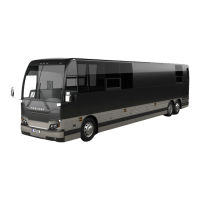CONTROLS/INSTRUMENTS
2 - 10
Battery
Lights when alternator is not functioning properly.
Battery balance
Lights when batteries are out of balance.
NOTE: Before seeking assistance, check that
the demand for the 12 volt power is not exceeding
rated amperage output of battery equalizer(s),
and also check circuit breaker on battery
equalizer(s) (for location, see page 4-17). Allow
at least 15 minutes to balance batteries after
corrective measures have been taken.
High or low battery voltage
Lights when battery voltage exceeds 30 volts or
drops below 24 volts.
Engine coolant temperature gauge
Indicates engine coolant temperature. Normal
reading should vary from 190 to 215°F (88 to
102° C).
In extremely hot weather and high altitude, the
coolant temperature can reach 215°F (102°C)
and more when climbing a long grade at full
throttle. If this situation occurs, the "check
engine" light will come on (at 217°F - 103°C) and
the engine overtemperature protection system
(EOP) will be activated. If the cooling system is
properly maintained, the temperature should
stabilize below the shut back temperature of
222°F (106°C) so the vehicle can operate
normally. See also item # 31 on page 2-7.
NOTE: Engine is not considered "overheating"
when below 215
°
F (102
°
C).
Oil pressure gauge
Indicates engine oil pressure. Normal reading at
operating temperature should vary from 50 to 70
psi (345 to 483 Kpa) at cruising speed.
Transmission oil temperature
gauge (Optional)
Indicates transmission oil temperature. Normal
reading can vary from 160 to 250°F (70 to
120°"C).
NOTE: On vehicles equipped with a trans-
mission retarder, the temperature may rise to a
maximum of 330ºF (165ºC) if operated for
extended periods.
Turbo boost pressure gauge (Optional)
Indicates turbo boost pressure in psi. Reading
depends on engine rpm and load conditions. It is

